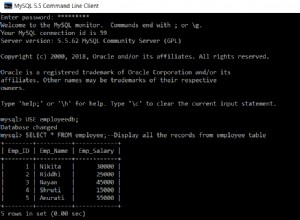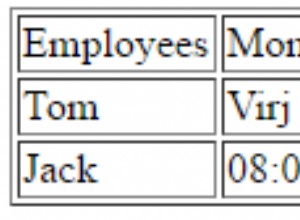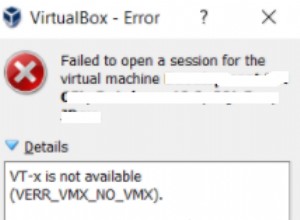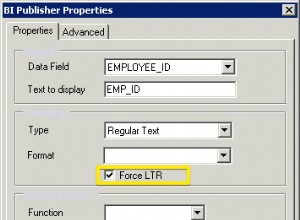Per lavorare con un cursore in PHP sono necessari tre passaggi aggiuntivi, rispetto all'accesso alle righe direttamente da un SELECT dichiarazione.
- Il primo passo è preparare una risorsa cursore in PHP usando
oci_new_cursor()funzione, che poi utilizzerai per associare il parametro appropriato. - Il secondo passaggio consiste nell'aggiungere un parametro su
oci_bind_by_name()funzione - Il terzo passaggio, dopo aver eseguito la consueta istruzione SQL, è chiamare
oci_execute()sulla risorsa cursore.
Il codice:
//Connection does not change
$db = "(DESCRIPTION=(ADDRESS_LIST = (ADDRESS = (PROTOCOL = TCP)(HOST = JXYX.com)(PORT = 1521)))(CONNECT_DATA=(SID=DHSJKS)))";
$conn = ocilogon("XXXXXX","XXXXXXXX",$db);
//Request does not change
$sql = 'BEGIN SP_GET_MY_DATA(:POP, :SEG, :DUR, :VIEW, :PAGE, :OUTPUT_CUR); END;';
//Statement does not change
$stmt = oci_parse($conn,$sql);
oci_bind_by_name($stmt,':POP',$pop);
oci_bind_by_name($stmt,':SEG',$seg);
oci_bind_by_name($stmt,':DUR',$dur);
oci_bind_by_name($stmt,':VIEW',$view);
oci_bind_by_name($stmt,':PAGE',$page);
//But BEFORE statement, Create your cursor
$cursor = oci_new_cursor($conn)
// On your code add the latest parameter to bind the cursor resource to the Oracle argument
oci_bind_by_name($stmt,":OUTPUT_CUR", $cursor,-1,OCI_B_CURSOR);
// Execute the statement as in your first try
oci_execute($stmt);
// and now, execute the cursor
oci_execute($cursor);
// Use OCIFetchinto in the same way as you would with SELECT
while ($data = oci_fetch_assoc($cursor, OCI_RETURN_LOBS )) {
print_r($data);
}
Non parlo molto bene Oracle (e inglese), quindi dovresti leggere questo tutorial . C'è un esempio interessante, guarda le Stored procedure e cursori di riferimento capitolo!
Spero che ti aiuti!




